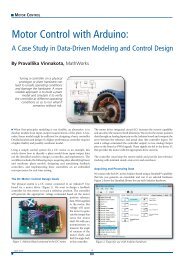Motor Control Lighting Development Tools Motor ... - ICC Media GmbH
Motor Control Lighting Development Tools Motor ... - ICC Media GmbH
Motor Control Lighting Development Tools Motor ... - ICC Media GmbH
You also want an ePaper? Increase the reach of your titles
YUMPU automatically turns print PDFs into web optimized ePapers that Google loves.
LIGHTINGSavings all along the road with LEDsBy Wolfgang Reis, EBV The fact that some LED components can berecycled is not just a positive aspect in environmentalterms, it also results in lower disposalcosts. There is much less of an LED left at theend of its useful life than of other types oflamp. LEDs offer many different savings: Theydo not have to be cleaned for example, nor –despite their 50,000 hour service lives – dothey need maintaining. And maintenance canbe very expensive in some cases, as the followingexample demonstrates. If a defective bulbcauses a traffic light to fail, it is not merely amatter of the cost of a new light, but also ofthe time and effort for staff to come out andreplace it; temporary traffic control by the policewhere appropriate; and possibly additionalrequired materials. The economic loss resultingfrom traffic congestion is a further factor.Though the acquisition cost of an LED andthe associated operating unit is higher than aconventional lamp, the savings over a periodof years far outweigh the difference in initialoutlay, because LEDs last in some cases 100times longer than bulbs.In order to deliver the light provided by conventionallamps, multiple LEDs are required.This does mean that the cost of lighting byLED is initially higher. It should be remembered,however, that the efficiency of LEDs ishigher and so energy costs will be lower. Aconventional 12 lm/W bulb uses three timesmore electricity than a white LED with a lightoutput of 40 lm/W to attain the same level ofbrightness. Also, LEDs generate less heat, sothe cost of air conditioning is reduced. Thestory is similar with regard to the use of LEDsin vehicles. The additional electronics required,the higher numbers of LEDs and their higherunit costs mean that the purchase price ishigher. However, manufacturers are able tomarket LED-powered lights as a profitable optionalextra, thereby also meeting the legal requirementto cut emissions. Moreover, vehicleowners profit from reduced fuel consumption.The reason is that a generator driven by wayof a belt by the engine generates the electricalenergy needed for the vehicle. When morepower is needed, the mechanical resistance ofthe engine increases, in turn increasing thefuel consumption. When LEDs are used, lesselectrical energy is needed. The resultant reductionin power consumption is importantto the automotive industry not only because ithelps cut CO2 emissions in line with legal requirements.Government moves to make drivingwith daytime running lights mandatory atall times are also leading motor manufacturersincreasingly to fit LEDs.According to the German Federal HighwayResearch Institute (Bundesanstalt für Straßenwesen),daytime running on conventional bulbheadlights results in an additional consumptionof 0.052 litres per 100 km, while the additionalconsumption with LEDs is 0.02 l/100 km. In ,this would mean the annual additional fuelconsumption resulting from permanent useof daytime running lights would be around0.3 per cent of the total with bulbs and 0.1 percent with LEDs. In other words: the total costof cars driving permanently with their dippedbeam headlights on (daytime running lights)resulting from the increase in fuel consumptionin Germany would be 630 million euros. Overthe long term, daytime running lights usingLEDs would cut that cost to 60 million euros.Another factor is that LEDs are so long-lastingthat they would even outlive the vehicles inwhich they were fitted.Assuming that LEDs are operated within thelimits specified by the manufacturers with regardto current and ambient temperature, andno environmental factors such as damp orchemicals lead to the premature destructionof the LED, the likelihood of a high-qualityLED suffering a total failure over its lifetime isnegligibly small. Failures of LED lamps usuallyresult from defective or ageing soldered points;the LED itself remains operative. It should,however, be borne in mind that there is a differencein lifetime between the various colours,as they are made by different technologies. Itcan generally be assumed that LEDs in red, orangeand yellow will age much less than greenand blue – and thus also white – LEDs. In typicalvehicle operation, red, yellow and orangeLEDs attain service lifetimes of around 7,000hours. Operating at normal ambient temperatureat 80 per cent of the application-specificmaximum permissible current, they attainaround 10,000 hours, and at 50 per centaround 100,000 hours. If white LEDs are operatedat half the starting current, their lifetimescan be expected to double. Double life canalso be expected if the LED is operated at anambient temperature 30 Kelvins below thestarting value. In contrast to bulbs, LEDs arestill lighting at the end of their lives, though at“time of death” their light intensity has fallento 50 per cent of its original level.Consequently, the decision as to which lightshould be used in applications in which replacementis complex and costly is easily madein favour of the LED. April 2013 12
















